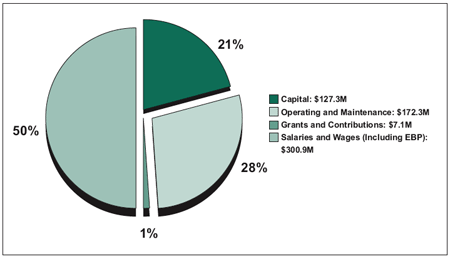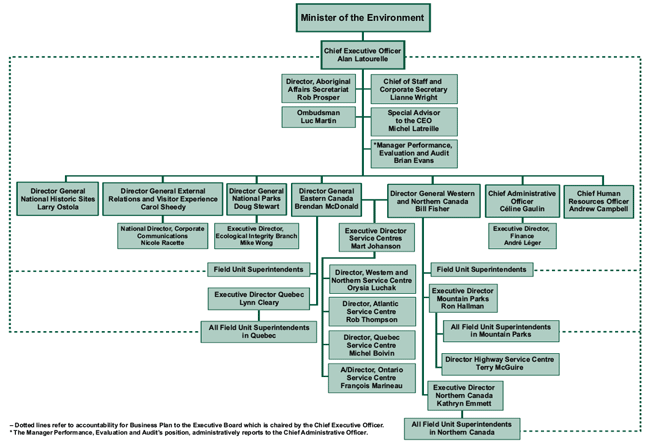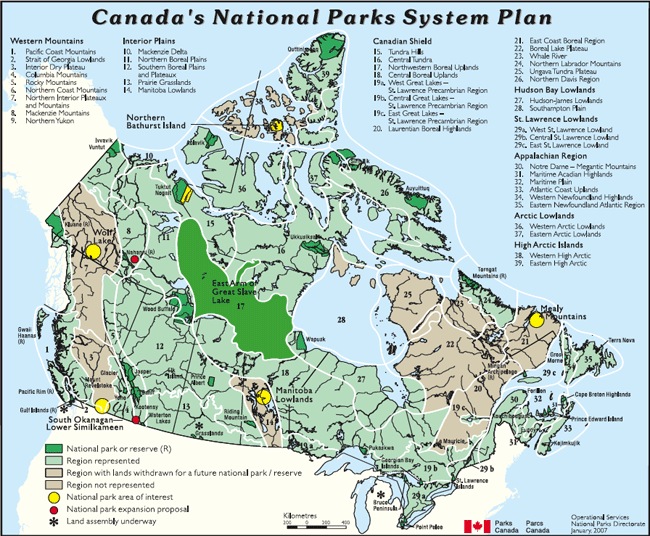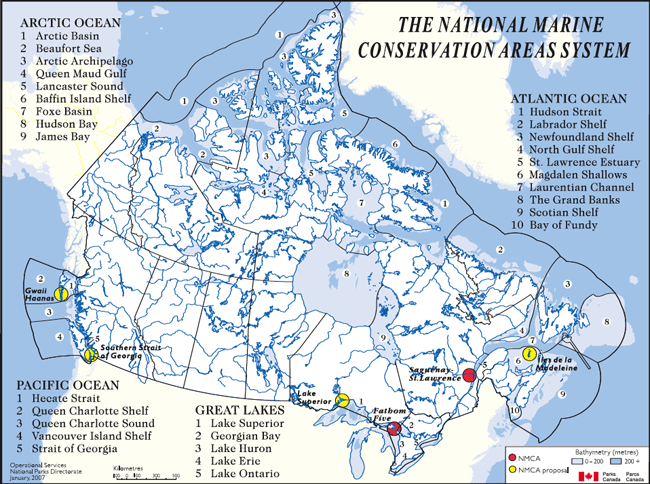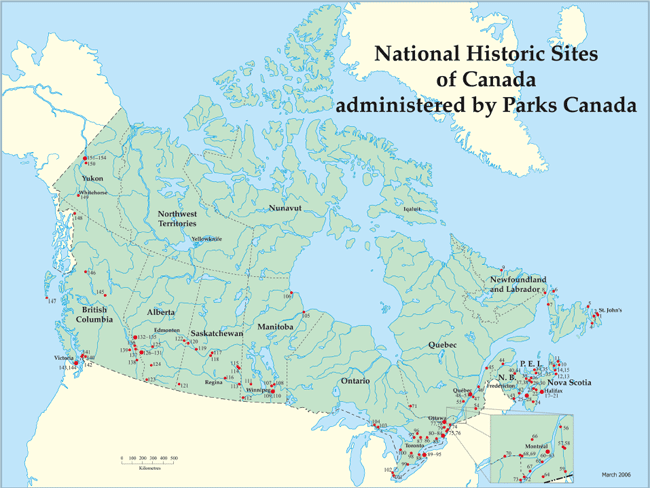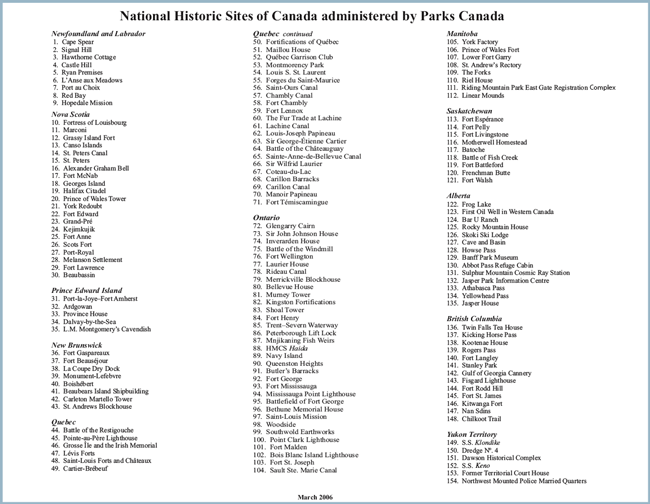Common menu bar links
Breadcrumb Trail
ARCHIVED - RPP 2007-2008
Parks Canada
 This page has been archived.
This page has been archived.
Archived Content
Information identified as archived on the Web is for reference, research or recordkeeping purposes. It has not been altered or updated after the date of archiving. Web pages that are archived on the Web are not subject to the Government of Canada Web Standards. As per the Communications Policy of the Government of Canada, you can request alternate formats on the "Contact Us" page.
Section I: Agency Overview
Minister’s Message

As Minister responsible for Parks Canada, I am pleased to present this Corporate Plan to the people of Canada. Canadians have been protecting and presenting their special heritage places since 1885, when Banff National Park—Canada’s first and the world’s third—was created.
In its stewardship of Canada’s treasured cultural and natural heritage places, Parks Canada must carry out a unique, challenging and exciting mission. Alone, of all the branches and departments of the federal government, Parks Canada has the dual responsibility of protecting environments and heritage places so that they will be preserved for future generations, and presenting them to Canadians so that they provide memorable experiences and learning opportunities.
Our national parks and national historic sites belong to all Canadians, and Parks Canada makes it possible for Canadians to have exceptional experiences at truly remarkable places, in a way that ensures the ecological integrity of the national parks, and that the commemorative integrity of our national historic sites is protected.
In 2007, this is a challenging task. Parks Canada is directly responsible for 42 national parks, two national marine conservation areas and 154 national historic sites, and encourages and supports the owners of an additional 762 historic sites. It oversees a total portfolio of assets worth more than $7 billion, and plays host to 22 million visitors a year.
The people who make up the Parks Canada organization are hard-working, dedicated and highly skilled professionals. They include visitor services officers, wardens, archaeologists and researchers, historians and ecologists. Together, they do a splendid job of protecting, managing and presenting a large, complex and extremely valuable nation-wide system of national treasures, on behalf of all Canadians.
This Corporate Plan provides the blueprint for how Parks Canada will go about protecting and presenting Canada’s natural and cultural heritage over the next few years. The Plan is key to the sustainable management of Canadians’ vast system of cultural and natural treasures.
One thing has not changed since the establishment of Banff National Park. Our national historic sites and national parks are an expression of faith in the future. These heritage places bring Canada’s history alive, are pathways to learning, and are magical landscapes where Canadians can experience some of the finest, most inspiring and unspoiled ecosystems on the planet. Through their protection, Parks Canada ensures that Canadians today and in the future can enjoy them, experience and learn from them, and become fully engaged in their continued stewardship. We must take care of our priceless natural and cultural assets, and this Corporate Plan spells out how the Government of Canada will do so.
![]()
The Honourable John Baird
Minister of the Environment
Management Representation Statement
I submit for tabling in Parliament, the 2007-2008 – 2011-2012 Report on Plans and Priorities (RPP) for Parks Canada.
This document has been prepared based on the reporting principles contained in the Guide for the Preparation of Part III of the 2007-2008 Estimates: Reports on Plans and Priorities and Departmental Performance Reports:
- It adheres to the specific reporting requirements of the Treasury Board Secretariat;
- It is based on the Agency’s Strategic Outcome and Program Activity Architecture that were approved by the Treasury Board;
- It presents consistent, comprehensive, balanced and accurate information;
- It provides a basis of accountability for the results achieved with the resources and authorities entrusted to Parks Canada; and
- It reports finances based on approved planned spending numbers from the Treasury Board Secretariat in the Report on Plans and Priorities.

Alan Latourelle
Chief Executive Officer
Parks Canada
Message from the Chief Executive Officer
Sharing the Passion – Sharing the Leadership

Parks Canada is known as a national institution steeped in a long-standing tradition of excellence and blessed with an incredible team of experienced and passionate staff and partners. Our history is marked by so many accomplishments. Over the years, through our work we have firmly established ourselves – in our communities, across Canada and internationally – as leaders in the field of protection of natural and cultural heritage and the provision of memorable visitor experiences and learning opportunities. Our efforts and successes continue to make citizens proud of Canada’s natural and cultural heritage.
On the world stage, the international community looks to Parks Canada because of the leadership role we play in many areas including the designation of world heritage sites; the protection of underwater archaeological resources; and the development and implementation of operational and policy innovation. Nationally, we are recognized as leaders in terms of service excellence to Canadians, whether it be through inviting others to work collaboratively with us and sharing the leadership, or through facilitating quality memorable experiences to people who visit our national historic sites, national parks and national marine conservation areas, inspiring them to become champions and ambassadors of Canada’s special places and stories. In many communities, we are contributing directly to the economic well-being and quality of life of our fellow Canadians. While there may be others involved in the protection of natural and cultural resources, or in education, we are the only federal organization with a national mandate that integrates protection, education and memorable experiences.
The environment is becoming increasingly important to Canadians, and there are increased threats from outside sources to our national historic sites and our national parks, but we are responding. Canada’s demographics are changing – the increased diversity of Canadians, changing expectations, urbanization – and we must respond. Increased competition for resources, for new talent and for partners and visitors means that we need to adjust how we do our business. Our ability to share our passion for Parks Canada programs and to share the leadership with others will ultimately determine our future success.
Our mandate has not changed and our responsibilities to all Canadians and visitors from around the world are not negotiable. Our national parks and national historic sites belong to all Canadians as exemplified in the dedication clause (art. 4.1) of the Canada National Parks Act:
The national parks of Canada are hereby dedicated to the people of Canada for their benefit, education and enjoyment, subject to this Act and the regulations, and the parks shall be maintained and made use of so as to leave them unimpaired for the enjoyment of future generations.
Our mandate is to facilitate memorable experiences in a way that ensures the protection of the ecological integrity of national parks and the commemorative integrity of national historic sites. Integration of protection, education and memorable experiences is the foundation for our work while ensuring that we are relevant to, and representative of Canadians. We don’t want to just be good at what we do. We are striving for excellence – in everything we do. And we can achieve this.
We are committed to creating the space where all people can share their stories, knowledge and concerns; a place where each voice is heard and valued. Our commitment, shared with our team members, Aboriginal peoples, stakeholders and visitors, will ensure that Canada’s treasures are enjoyed and passed on unimpaired to our grandchildren and future generations. This will be our legacy.

Alan Latourelle
Chief Executive Officer
Parks Canada
Planning Overview and Agency Priorities
Agency Budget
Planned Spending and Full Time Equivalents (FTE)
| Forecast Spending |
Planned Spending
|
|||||
| 2006-2007* | 2007-2008 | 2008-2009 | 2009-2010 | 2010-2011 | 2011-2012 | |
| $ Thousands | 649,527 | 607,635 | 609,104 | 614,094 | 609,094 | 609,094 |
| FTE | 4,200 | 4,161 | 4,161 | 4,153 | 4,153 | 4,153 |
* Reflects the best forecast of total net planned spending to the end of the fiscal year.
Figure 2: Parks Canada Budget 2007-2008
Summary Information
Mandate
On behalf of the people of Canada, we protect and present nationally significant examples of Canada’s natural and cultural heritage, and foster public understanding, appreciation and enjoyment in ways that ensure the ecological and commemorative integrity of these places for present and future generations.
Financial Resources ($ Thousands)
| 2007-2008 | 2008-2009 | 2009-2010 | 2010-2011 | 2011-2012 |
|---|---|---|---|---|
|
607,635
|
609,104
|
614,094
|
609,094
|
609,094
|
Human Resources (FTE)
| 2007-2008 | 2008-2009 | 2009-2010 | 2010-2011 | 2011-2012 |
|---|---|---|---|---|
|
4,161
|
4,161
|
4,153
|
4,153
|
4,153
|
Agency Priorities
| Name |
Type
|
|---|---|
| 1. Create national parks and national marine conservation areas in unrepresented regions. |
2
|
| 2. Complete or expand some existing parks. |
2
|
| 3. Designate and commemorate places, persons and events of national historic significance. |
2
|
| 4. Designate other heritage places. |
2
|
| 5. Maintain or improve the ecological integrity of national parks, and the sustainability of national marine conservation areas. |
2
|
| 6. Maintain or improve the commemorative integrity of national historic sites, and the state of other cultural resources administered by Parks Canada. |
2
|
| 7. Support, maintain and improve the commemorative integrity of national historic sites and the state of heritage resources not administered by Parks Canada. |
2
|
| 8. Encourage the support and involvement of Canadians and stakeholders and their knowledge and appreciation of Canada’s heritage places. |
2
|
| 9. Facilitate experiences that provide learning opportunities, visitor satisfaction and personal connections. |
2
|
| 10. Provide responsible environmental stewardship and heritage conservation. |
2
|
| 11. Provide safe highways, open to through traffic, and minimize their environmental impacts. |
2
|
| 12. Maintain condition of waterways, carry out water control functions, and meet water level obligations. |
2
|
| 13. Demonstrate accountability and effective decision-making and deliver timely, accessible and reliable management services. |
2
|
| 14. A diverse and capable workforce, working in a positive and enabling environment which is reflective of the HR Values and Operating Principles. |
2
|
Notes: Type: 1: new; 2: ongoing; 3: previously committed to.
Program Activities by Strategic Outcome
| Expected Results* | Planned Spending ($ thousands) | Contributes to the following priority | |||||
|---|---|---|---|---|---|---|---|
| 2007-2008 | 2008-2009 | 2009-2010 | 2010-2011 | 2011-2012 | |||
| Strategic Outcome: | Protect and present nationally significant examples of Canada’s natural and cultural heritage, and foster public understanding, appreciation and enjoyment in ways that ensure the ecological and commemorative integrity of these places for the present and future generations. | ||||||
| Establish Heritage Places | * Refer to Figure 4 for a listing of Expected Results by Program Activity. | 24,984 | 24,153 | 23,793 | 23,793 | 23,793 | Priority No. 1, 2, 3 and 4 |
| Conserve Heritage Resources | 206,895 | 209,190 | 214,885 | 214,885 | 214,885 | Priority No. 5, 6, and 7 | |
| Promote Public Appreciation and Understanding | 34,230 |
27,631 | 28,817 | 28,817 | 28,817 | Priority No. 8 | |
| Enhance Visitor Experience | 267,327 | 272,721 | 277,742 | 277,742 | 277,742 | Priority No. 9 | |
| Townsite Management | 12,665 | 12,775 | 12,983 | 12,983 | 12,983 | Priority No. 10 | |
| Throughway Management | 61,535 | 62,633 | 55,873 | 50,873 | 50,873 | Priority No. 11 and 12 | |
Roles and Responsibilities
The Parks Canada Agency is responsible for the implementation of policies and programs that relate to Canada’s national parks, national historic sites, national marine conservation areas, other protected heritage areas, and heritage protection programs.
The Agency's actions to establish, protect and present Canada’s special heritage places are taken chiefly with regard to: the System of National Parks of Canada (Figure 5), the System of National Marine Conservation Areas of Canada (Figure 6), and the System of National Historic Sites (Figure 7).
The Agency’s work is guided by the Parks Canada Charter (Figure 1, inside front cover), which states the Agency’s mandate and role, as well as its commitments to Canadians. Parks Canada strives to apply the Charter when carrying out its responsibilities.
Parks Canada derives its mandate from several pieces of legislation. The 1998 Parks Canada Agency Act (PCAA) established it as a separate Government of Canada Agency. The Historic Sites and Monuments Act of 1953 provides for the designation of national historic sites as well as the legislative basis for acquiring and for contributing directly to the care and preservation of these sites. The Canada National Parks Act, passed in 2000, modernized Parks Canada’s historic role and affirmed ecological integrity as the Agency priority when considering all aspects of national park management. The Canada National Marine Conservation Areas Act, passed in 2002, provides for the creation of national marine conservation areas representative of the country’s oceans and Great Lakes’ waters.
Parks Canada has the lead role for developing policy and implementing the Historic Places Initiative; a significant collaborative conservation efforts related to the nation’s built heritage.
Parks Canada, together with the Department of Fisheries and Oceans and the Department of the Environment, has responsibility to implement the Species at Risk Act.
Parks Canada administers the Heritage Railway Stations Protection Act and the Historic Canals Regulations, pursuant to the Department of Transport Act. Parks Canada is also responsible, with the Department of Transport, for jointly developing and implementing Heritage Wreck Regulations under the Canada Shipping Act.
For a complete list of the legislation governing the Parks Canada Agency, see Annex 4.
There were 916 sites designated as being of national historic significance as of March 31, 2006. Of these, 154 are directly administered by Parks Canada. Designations have been made for 587 persons of national historic significance and 360 historically significant events. There are 42 national parks representing 28 of Canada’s 39 distinct natural regions, and there are two operating sites in the national marine conservation areas system, representing two of Canada’s 29 marine regions.
Parks Canada leads programs related to the commemoration and protection of grave sites of former Prime Ministers, federal heritage buildings, heritage railway stations, heritage rivers, other built heritage programs such as the Canadian Register of Historic Places, and for the United Nations Educational Scientific and Cultural Organization’s (UNESCO) Biosphere Reserves Program Initiative. Parks Canada leads the implementation of Canada’s obligations under the World Heritage Convention; works in cooperation with Environment Canada to help coordinate national implementation of the Convention on Biological Diversity Program of Work on Protected Areas; and provides leadership on other international heritage conservation agreements.
There are more than 22 million annual visits to Canada’s protected heritage areas, and more than
5 million annual visits to the Agency website. The Agency supports 38,000 direct jobs for Canadians, in more than 460 communities.
The Parks Canada Agency reports to Parliament through the Minister of the Environment.
Operating Environment
Internal and External Factors Influencing the Agency
- Changing Demographics of Canada
The Agency recognizes that the social landscape of Canada is changing. In order to remain relevant to Canadians, the Agency will need to explore better ways to connect with, engage and respond to the needs and interests of young people, as well as urban dwellers, new immigrants and ethno-cultural communities. As a first step, the Agency must better understand the changing leisure patterns of Canadians and visitors from abroad. Such analysis will assist the Agency in ensuring that the products, services and facilities offered at national parks and national historic sites continue to provide visitors with meaningful experiences in innovative and interactive ways. - Engage Aboriginal Peoples, Partners and Stakeholders
Parks Canada cannot act unilaterally in achieving its mandate to protect and present Canada’s natural and cultural heritage. The Agency must continue to build strong and trusting relationships with Aboriginal communities and to work, collaboratively, with partners and stakeholders, wherever possible, if it is to be successful in achieving its goals. - Environmental Factors
Native biodiversity and habitat are under considerable stress and have suffered progressive loss. In the past 30 years, Canada has also lost more than 20% of its pre-1920 heritage buildings to demolition. In light of this, the Agency will continue its efforts to build a culture of conservation in Canada for the protection and sustainability of heritage resources for the future.
Minister’s Round Table on Parks Canada
The Parks Canada Agency Act requires that the Minister convene, at least every two years, a round table of persons interested in matters for which the Agency is responsible, and who will advise the Minister on the performance of the Agency.
The 2005 Minister’s Round Table had two themes. The first was entitled “towards a culture of conservation,” and the second, “facilitating memorable visitor experiences.” Participants made recommendations in three areas: support towards building a culture of conservation by improving communications and making use of best practices and the traditional approaches and knowledge of Canada’s indigenous peoples; a call to strengthen research, recapitalize assets and provide functional leadership for visitor experience within the Agency; and, the continued engagement of Aboriginal peoples and support of Aboriginal languages and traditions.
Actions to address the recommendations from the Round Table are outlined in this plan. For more information please visit http://www.pc.gc.ca/agen/trm-mrt/2005/index-eng.asp.
The next Minister’s Round Table will be held in 2007.
Aboriginal Relations
Canada’s special relationship with Aboriginal peoples has been set out and defined by The Constitution Act, 1982, by legal statutes, and by courts of law. Parks Canada considers Aboriginal peoples, not as stakeholders but as privileged partners. There are significant ways in which the relationship between Parks Canada and Aboriginal peoples differ from those of stakeholders. These relate primarily to existing Aboriginal and treaty rights, to obligations under land claim settlements and to ensuring that the timetable and decision-making processes of Aboriginal groups are respected and valued during consultation processes.
The establishment and management of a number of national historic sites, most of the national marine conservation areas and the majority of national parks have depended on the extraordinary sense of sharing, the pragmatic wisdom and the deeply cooperative spirit of Aboriginal peoples.
Parks Canada’s Aboriginal Affairs Secretariat provides national leadership and support for these aims.
The Aboriginal Consultative Committee, an advisory body, has been established to provide expert advice to the CEO of Parks Canada.
With Aboriginal elders and communities across the country, Parks Canada is pursuing five key objectives:
- Increase Aboriginal interpretation and presentation at national historic sites and national parks;
- Build relationships between all senior officials of Parks Canada and aboriginal communities;
- Improve employment opportunities for Aboriginal young people;
- Foster Aboriginal economic opportunities in and in proximity to heritage places; and,
- Make the system of national historic sites more representative of aboriginal heritage.
Activities related to these five objectives are outlined in this plan.
Strategic Environmental Assessment
Strategic Environmental Assessment (SEA), the requirement for which sprung from a Cabinet Directive, is a systematic, comprehensive process of evaluating the environmental aspects of a proposed policy, plan or program and its alternatives. SEA is required when the proposal may result in important positive or negative environmental effects and, Cabinet or Ministerial approval is needed.
The Parks Canada Agency is committed to developing and implementing a SEA management system over the life of this Corporate Plan. The management system will define roles and responsibilities for SEA, outline SEA tracking and monitoring responsibilities, and provide training and guidance to staff on how to incorporate SEA principles into their decision-making. Because SEA summaries are elements of published plans that are posted to the Agency Internet, the Agency will demonstrate to Canadians that consideration of environmental factors is an essential element in the delivery of its mandate.
Parks Canada Program Activity Architecture
Parks Canada delivers its mandate through a program activity architecture (PAA), composed of eight program activities (see Figure 4 for details). The PAA reflects how accountabilities are managed in the Agency and is the basis for reporting to Parliament and to Canadians. The program activities are linked by many interconnected priorities and
planned results; as such, they constitute the platform on which Parks Canada defines its contribution to federal strategic outcomes for Canadians.
(See Canada’s Performance Report http://www.tbs-sct.gc.ca/report/govrev/2005/cp-rc-eng.asp.)
The core programs are delivered through the first four program activities: Establish Heritage Places, Conserve Heritage Resources, Promote Public Appreciation and Understanding, and Enhance Visitor Experience. The establishment of national historic sites, national parks, national marine conservation areas and other heritage places are addressed under Program Activity 1. The ecological integrity of Canada’s national parks, sustainable management of national marine conservation areas and commemorative integrity of national historic sites are addressed under Program Activity 2. Program Activity 2 also includes all other conservation plans, including work to protect cultural resources administered by Parks Canada, as well as by other jurisdictions and non-governmental bodies.
Program Activities 3 and 4 address respectively the promotion of public appreciation and understanding, and the enhancement of the visitor experience. Parks Canada with its partners will offer a range of activities and services to Canadians to enhance their enjoyment and help them benefit from these special places. Specific programs that promote appreciation and understanding respond to Parks Canada’s desire to present Canada’s heritage both to visitors and to Canadians in their daily lives. Together, they allow Parks Canada to provide visitors with opportunities for meaningful experiences at national historic sites, national parks and national marine conservation areas in ways that respond to their needs and expectations.
Program Activities 5 and 6 relate to infrastructure, transportation and townsites management. Visitors rely on townsites as staging areas to prepare for a national park experience, while at the same time visitors and local residents depend on Parks Canada to keep highways safe and canal operations functioning for nautical activities, watercraft transportation and water management issues.
Program Activities 7 and 8 reflect corporate services which support the provision of programs and services to Canadians.
Benefits to Canadians
The following descriptions of Parks Canada’s program activities (PA) illustrate how the Agency provides benefits for Canadians.
PA1 Establish Heritage Places
Canada’s national parks and national marine conservation areas, as well as the persons, places and events of national historic significance to Canada, are symbols to the world and are part of what we stand for as a country. Given we are one of the oldest nations in the world with a rich and diverse history, preservation of our history is of key importance. Designation of persons, places and events of national significance under the National Historic Sites System Plan safeguards and chronicles the determination and ingenuity of Canadians and the contributions they have made. Recognition of all historic places in Canada through the Canadian Register of Historic Places enables Canadians to appreciate the full range of historic places that are significant locally, provincially and nationally. Protection of national parks and national marine conservation areas ensure that many of Canada’s most special natural heritage resources will not be lost. Current and future generations will enjoy a system of protected heritage areas that represent the full mosaic of diverse natural and cultural assets.
PA2 Conserve Heritage Resources
Ecological integrity is the cornerstone underlying the management of national parks and the long-term preservation of biodiversity and harmonious biological dynamics. Commemorative integrity of national historic sites aims at conserving the national and historic significance of these places by maintaining their lasting contribution to our history. Environmental sustainability is key to national marine conservation areas and requires that renewable resources be managed without compromising the ecosystems with which they are associated. Parks Canada protects nationally significant examples of Canada’s natural and cultural heritage so that citizens of today and tomorrow can experience and be inspired by the special places and rich stories of our nation. From our special heritage places, Canadians draw a shared understanding of our national identity.
PA3 Promote Public Appreciation and Understanding
Parks Canada builds knowledge, appreciation and support of Canada’s rich natural and cultural heritage through evocative learning experiences, dissemination of information to the public and close engagement of stakeholders and partners. By way of these education and outreach activities, Canadians will gain a greater connection to their history and develop a culture of conservation. This appreciation benefits Canadians and empowers them to become supporters in the protection and presentation of our nation’s special heritage places.
PA4 Enhance Visitor Experience
Canadians are offered opportunities to enjoy and appreciate Canada’s natural and cultural heritage through the protection or conservation of natural and cultural heritage of national significance as well as the provision of services, facilities and programs provided by Parks Canada. The Agency stages meaningful experiences that help to promote healthy lifestyle and foster a shared sense of responsibility for environmentally and culturally appreciative activities. Experiences gained through visits to well-conserved and accessible national parks, national historic sites and national marine conservation areas leave visitors with a clear and strong sense of connection to nature and history, adding to the well-being and health of Canadians.
PA5 Townsite Management
Parks Canada’s townsites facilitate visitation, as well as preserve and protect built heritage and archaeological resources. Considered premium visitor destinations by the traveling public, the townsites contribute considerable economic benefits to Canada. Through growth management strategies, the Agency demonstrates sustainable forms of development to Canadians. Townsites provide excellent case studies in conservation and education, and cultivate national park model communities where stewardship, sustainability and best practices are encouraged and rewarded.
PA6 Throughway Management
The highways and waterways maintained under the responsibility of Parks Canada are of great benefit to Canadians. Highways and bridges remain open and continue to provide reliable, safe through-transit in a manner that reduces wildlife-traffic conflicts and minimizes ecological impacts. They also provide
vital access to many parks facilities and associated visitor experience opportunities. Waterways remain open and provide reliable, safe through-transit and recreation, contributing to the efficient movement of people and commercial goods, while water levels and watersheds are managed in order to maintain healthy ecosystems and contribute to community and industrial water
supplies.
PA7/8 Corporate Services
Informed management decisions respect public service values, reflect probity and focus on accountability for achieving relevant results for Canadians. Through strategic decision-making, Parks Canada maximizes the resources devoted directly to program activities, in order to provide value for money and demonstrate clear stewardship. The Agency is working to maintain a workforce that reflects the mosaic of Canadian society. For Canadians to be able to judge its performance, public reporting will be balanced, transparent and easy to understand. It will demonstrate to Canadians that it is well managed and can deliver on defined commitments by having in place appropriate mechanisms to handle everyday operations and long-term strategic plans to fulfill its mandate.
Management Planning
Management planning at the individual park or site level integrates and translates these closely related and mutually supportive program activities into action. Each national historic site, national park and national marine conservation area management plan implements the direction set out by the Corporate Plan for all program activities, and sets out strategies and targets to deliver results and achieve outcomes. These plans are key accountability documents, and inform the public about how Parks Canada carries out its mandate.
Management Environment
In keeping with the government priority of establishing the components for good management, a series of tools, good practices and management requirements has been developed. The purpose is to ensure that Parks Canada has an integrated management, resources, and results structure that is current and consistent with the way it manages programs and related activities, and that allocates resources to achieve expected results and meet associated performance measures. Parks Canada is refining its management practices by integrating innovative tools and appropriate training. Accurate and comparable financial and non-financial information enable Parks Canada to link expenditure and program performance information to priorities for more effective planning, monitoring and reporting. Parks Canada’s management structure focuses on the achievement of results, and on reporting them in simple and understandable ways to elected officials and to Canadians, based on credible, reliable and balanced information.
Organization
Parks Canada’s Executive Board, comprised of the Chief Executive Officer and other senior managers depicted in the following Organization Chart, sets the priorities for the organization. Program delivery is the responsibility of Parks Canada’s 32 field units. Field units are groupings of national parks, national historic sites and national marine conservation areas. There are four service centres, which support the organization in a variety of professional and technical disciplines, such as biology and archaeology.
Figure 3: Parks Canada Organization Chart
Figure 4: Parks Canada Strategic Planning Framework
| Strategic Outcome: | Protect and present nationally significant examples of Canada’s natural and cultural heritage, and foster public understanding, appreciation and enjoyment in ways that ensure the ecological and commemorativeintegrity of these places for the present and future generations. | ||
|---|---|---|---|
|
Program Activity*
|
Description
|
Planned Results/Priority
|
Performance Expectations
|
|
1. Establish Heritage Places Capital: Salaries and Wages: Other Operating: Total: $24,984 |
The establishment of heritage places includes systems planning, consulting with stakeholders and the public, negotiating with other governments and Aboriginal organizations, obtaining ministerial approval, and establishing national parks and national marine conservation areas, and designating national historic sites of Canada, as well as other heritage places, for inclusion in the national systems. | 1. Create national parks and national marine conservation areas in unrepresented regions. | 1. Increase the number of represented terrestrial regions from 25 in March 2003 to 30 of 39 by March 2008, and increase the number of represented marine regions from two in March 2003 to four of 29 by March 2008. |
| 2. Complete or expand some existing parks. | 2. Expand two national parks by March 2008, and increase the targeted land holdings in three unfinished national parks. | ||
| 3. Designate and commemorate places, persons and events of national historic significance. |
3. Designate, on average, 24 new places, persons and events per year. 4. On average, 30 commemorative plaques placed annually. |
||
| 4. Designate other heritage places. |
5. List 10,000 designated historic places on the Canadian Register of Historic Places by March 2009, and 17,500 by 2014. 6. Designate, in partnership with others, federal heritage buildings. |
||
|
2.Conserve Heritage Resources
Capital: Salaries and Wages: Other Operating: Total: |
Conserving heritage resources includes the maintenance or improvement of ecological integrity in national parks; the sustainable use of national marine conservation areas and the protection of unique marine ecosystems; ensuring the commemorative integrity of national historic sites managed or influenced by Parks Canada; and the protection and management of cultural resources under the administration of Parks Canada that are not associated with national historic sites. | 5. Maintain or improve the ecological integrity of national parks and the sustainability of national marine conservation areas. |
7. National park and NMCA management plans will be on schedule and consistent with management plan guidelines by March 2010. 8. Develop fully functioning ecological integrity monitoring and reporting systems for all national parks by March 2008. 9. Develop selected indicators and protocols for measuring NMCA ecological sustainability by March 2009. 10. Improve aspects of the state of ecological integrity in each of Canada’s 42 national parks by March 2014. 11. Meet targets for five measures of environmental impacts of Parks Canada’s operations: greenhouse gas emissions, petroleum storage tanks, contaminated sites, halocarbons and polychlorinated biphenyls (PCBs). |
|
6. Maintain or improve the commemorative integrity of national historic sites, and the state of other cultural resources administered by Parks Canada.
|
12. Complete NHS management plans, consistent with management plan guidelines by March 2008. 13. Improve 75% of the elements of commemorative integrity rated as poor to at least fair condition, within five years of the original assessment. 14. Improve the state of other cultural resources managed by Parks Canada by March 2014. |
||
| 7. Support maintaining and improving the commemorative integrity of national historic sites, and the state of heritage resources not administered by Parks Canada. |
15. Other owners of national historic sites are aware of commemorative integrity and have access to information on best practices in maintaining it. 16. Provide advice, recommendations or certification of interventions to built cultural heritage consistent with The Standards and Guidelines for the Conservation of Historic Places in Canada as opportunity permits. |
||
|
3. Promote Public Appreciation and Understanding
Capital: Salaries and Wages: Other Operating: Total: |
Promoting public appreciation and understanding involves programs and activities that are aimed at reaching Canadians at home, at leisure, at school and in their communities with relevant information and innovative learning opportunities that respond to their needs and interests. | 8. Encourage the support and involvement of Canadians and stakeholders and their knowledge and appreciation of Canada’s heritage places. | 17. Develop indicators, expectations and protocols for measuring public appreciation and understanding of Canadians and stakeholders by May 2007. |
|
4. Enhance Visitor Experience
Capital: Salaries and Wages: Other Operating: Total: |
The visitor experience is the cumulative outcome of all aspects of each visit, including interactions with Parks Canada and its partners. It includes client focused services, programs and infrastructure that support the provision of pre- and on-site trip planning information, reception and orientation, interpretation, campgrounds, hiking trails and other recreational activities, visitor safety and the ongoing post visit relationship. | 9. Facilitate experiences that provide learning opportunities, visitor satisfaction and personal connections. | 18. 10% increase in the number of visits to targeted national historic sites by March 2008. 19. 50% of visitors to national parks and national marine conservation areas, and 80% of visitors to national historic sites will participate in learning experiences at all surveyed sites. 20. 85% of visitors are satisfied, and 50% are very satisfied, with their experience at all surveyed sites. 21. Optimize the number of visitors who report a personal connection to the park or site visited (target to be established by October 2007). |
|
5. Townsite Management
Capital: Salaries and Wages: Other Operating: Total: |
Townsite management activities include the operation of 5 townsite communities within Canada’s national parks, and the provision of municipal services such as drinking water, snow removal, garbage pick-up and disposal, sewage treatment, road and street maintenance, and fire services to support visitors and residents. | 10. Provide responsible environmental stewardship and heritage conservation. |
22. Meet targets for legislated limits to growth, sewage effluent quality and management of contaminated sites and set targets for solid waste diversion and water conservation by March 31, 2008. 23. Townsites meet their targets for the protection of priority heritage assets owned by Parks Canada. |
|
6. Throughway Management
Capital: Salaries and Wages: Other Operating: Total: |
Throughway management involves the operation, maintenance and repair of roads, bridges, provincial and inter-provincial highways and waterways that connect communities and pass through national parks and national historic sites. Parks Canada is also responsible for nine national historic canals and waterways, including the Trent-Severn Waterway and the Rideau, Lachine and Chambly canals. | 11. Provide safe highways, open to through traffic, and minimize their environmental impacts. |
24. Highways are open to through traffic. 25. Maintain highways in a condition that minimizes risk to users. 26. Minimize environmental impacts of highways. |
| 12. Maintain condition of waterways, carry out water control functions, and meet water level obligations. |
27. 75% of waterway assets are maintained in at least fair condition. 28. Develop inventory of water control obligations, targets, and protocols for measuring compliance by March 2008. |
||
|
Corporate Services
7. Management of Parks Canada 8. People Management |
Corporate services include budgeting and programming; financial investment and administrative management; real property and asset management; the development of legislation and policy; senior management and the management of human resources. | 13. Demonstrate accountability and effective decision-making, and deliver timely, accessible and reliable management services. |
29. Score average or above on 100% of indicators in Treasury Board Management Accountability Framework assessment.
|
| 14. A diverse and capable workforce, working in a positive and enabling environment which is reflective of the HR Values and Operating Principles. |
30. Five year Independent Report on the Agency’s Human Resource Regime shows consistency between the Agency’s HR Values and Operating Principles and the HR Regime, and improvements in targeted areas. 31. A workforce that is representative of the Canadian population as measured by labour force availability by 2009. |
||
*Capital, Salaries and Wages and Other Operating figures are forecasts for 2007/2008, ($ thousands).
Figure 5: The System of National Parks of Canada
Figure 6: The System of National Marine Conservation Areas of Canada
Figure 7: National Historic Sites of Canada administered by Parks Canada

